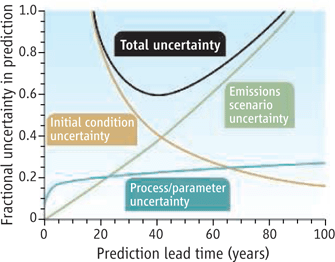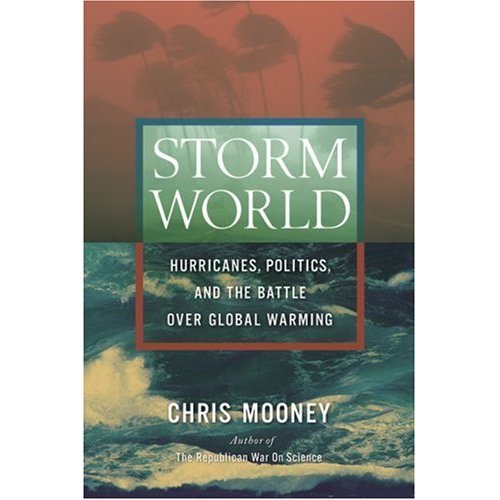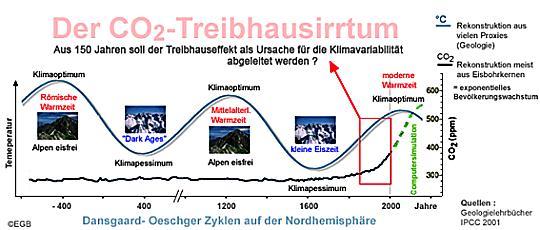We often get requests to provide an easy-to-understand explanation for why increasing CO2 is a significant problem without relying on climate models and we are generally happy to oblige. The explanation has a number of separate steps which tend to sometimes get confused and so we will try to break it down carefully.
[Read more…] about The CO2 problem in 6 easy steps
Climate Science
Ozone impacts on climate change
In a nice example of how complicated climate feedbacks and interactions can be, Sitch and colleagues report in Nature advance publication on a newly modelled effect of ground level (or tropospheric) ozone on carbon uptake on land (BBC). The ozone they are talking about is the ‘bad’ ozone (compared to ‘good’ stratospheric ozone) and is both a public health hazard and a greenhouse gas. Tropospheric ozone isn’t directly emitted by human activity, but is formed in the atmosphere as a result of photolytic reactions related to CH4, CO, NOx and VOCs (Volatile Organic Compounds like isoprene, benzene etc.) – the so-called ozone precursors.
It’s well known that increased ozone levels – particularly downwind of cities – can be harmful to plants, and in this new study with a carbon-climate model, they quantify how by how much increasing ozone levels make it more difficult for carbon to be sequestered by the land biosphere. This leads to larger CO2 levels in the atmosphere than before. Hence the ozone has, as well as its direct effect as a greenhouse gas, an indirect effect on CO2, which in this model at least appears to be almost as large.
Actually it’s even more complicated. Methane emissions are one of the principal causes of the rise of ozone, and the greenhouse effect of ozone can be thought of as an indirect effect of CH4 (and CO and VOCs). But while NOx is an ozone precursor, it actually has an indirect effect that reduces CH4, so that the net impact of NOx has been thought to be negative (i.e. the reduction in CH4 outweighs the increase of ozone in radiative forcing – see this paper for more details). This new result might prompt a re-adjustment of that balance – i.e. if the ozone produced by NOx has a stronger effect than previously thought (through this new indirect mechanism), than it might outweigh the reduction in CH4, and lead to NOx emissions themselves being a (slightly) positive forcing.
In a bizarre way this is actually good news. There are plenty of reasons to reduce NOx emissions already because of it’s impact on air pollution and smog, but this new result might mean that reductions wouldn’t make climate change any worse. It also, once again, highlights the role of CH4 (the second biggest GHG forcing), and points out a further reason (if that was required) why further methane reductions could be particularly welcome in moderating future changes in climate and air quality.
Green and Armstrong’s scientific forecast
There is a new critique of IPCC climate projections doing the rounds of the blogosphere from two ‘scientific forecasters’, Kesten Green and Scott Armstrong, who claim that since the IPCC projections are not ‘scientific forecasts’ they must perforce be wrong and that a naive model of no change in future is likely to be more accurate that any IPCC conclusion. This ignores the fact that IPCC projections have already proved themselves better than such a naive model, but their critique is novel enough to be worth a mention.
[Read more…] about Green and Armstrong’s scientific forecast
Friday roundup
An eclectic round-up of the week’s climate science happenings (and an effort to keep specific threads clear of clutter).
It’s the sun! (not)
As regular readers here will know, the big problem for blaming the sun for the recent global warming is that there hasn’t been a trend in any index of solar activity since about 1960, and that includes direct measurements of solar output by satellites since 1979. Well, another paper, has come out saying exactly the same thing. This is notable because the lead author Mike Lockwood has worked extensively on solar physics and effects on climate and certainly can’t be credibly accused of wanting to minimise the role of solar forcing for nefarious pro-CO2 reasons!
Stefan was quoted in Nature as saying this is the ‘last nail in the coffin’ for solar enthusiasts, but a better rejoinder is a statement from Ray P: “That’s a coffin with so many nails in it already that the hard part is finding a place to hammer in a new one.”
TGGWS Redux
The still-excruciating ‘Great Global Warming Swindle’ got another outing in Australia this week. The heavily edited ‘new’ version dumped some of the obviously fake stuff that was used the first time around, and edited out the misleading segment with Carl Wunsch. There is some amusing feedback in the post-show discussion panel and interview (via DeSmogBlog).
RC Wiki
As an aside, this is as good a time as any to point people to a new resource we are putting together: RC Wiki, which is an index to the various debunkings of the contrarian articles, TV programs, and internet pseudo-science that is out there. The idea is to have a one-stop shop so that anyone who comes across a piece and wants to know what the real story just has to start there. For instance, the page on TGGWS has a listing of many of the substantive criticisms from the time of the first showing.
Editing the wiki is by invitation only, but let us know if you want to help out, or if you have any suggestions or comments.
The sweet spot for climate predictability

One could quibble with the details (we’d put the sweet spot a little earlier) but the underlying idea is sound, and in judging climate forecasts, it will be projections in that range that should be judged (i.e. the early Hansen projections).
Making sense of Greenland’s ice
A widely publicised paper in Science last week discussed the recovery ancient DNA from the base of the Dye-3 ice core (in southern Greenland). This was an impressive technical feat and the DNA recovered may well be the oldest pure DNA ever, dating back maybe half a million years. However much of the press coverage of this paper dwelt not on the positive aspects of the study but on its supposed implications for the stability of the Greenland ice sheet and future sea level rise, something that was not greatly discussed in the paper at all. So why was this?
[Read more…] about Making sense of Greenland’s ice
No man is an (Urban Heat) Island
Observant readers will have noticed a renewed assault upon the meteorological station data that underpin some conclusions about recent warming trends. Curiously enough, it comes just as the IPCC AR4 report declared that the recent warming trends are “unequivocal”, and when even Richard Lindzen has accepted that globe has in fact warmed over the last century.
The new focus of attention is the placement of the temperature sensors and other potential ‘micro-site’ effects that might influence the readings. There is a possibility that these effects may change over time, putting in artifacts or jumps in the record. This is slightly different from the more often discussed ‘Urban Heat Island’ effect which is a function of the wider area (and so could be present even in a perfectly set up urban station). UHI effects will generally lead to long term trends in an affected station (relative to a rural counterpart), whereas micro-site changes could lead to jumps in the record (of any sign) – some of which can be very difficult to detect in the data after the fact.
There is nothing wrong with increasing the meta-data for observing stations (unless it leads to harassment of volunteers). However, in the new found enthusiasm for digital photography, many of the participants in this effort seem to have leaped to some very dubious conclusions that appear to be rooted in fundamental misunderstandings of the state of the science. Let’s examine some of those apparent assumptions:
[Read more…] about No man is an (Urban Heat) Island
A Saturated Gassy Argument O Argumento da Saturação Gasosa
A guest post by Spencer Weart, in collaboration with Raymond T. Pierrehumbert
The simple physics explanations for the greenhouse effect that you find on the internet are often quite wrong. These well-meaning errors can promote confusion about whether humanity is truly causing global warming by adding carbon dioxide to the atmosphere. Some people have been arguing that simple physics shows there is already so much CO2 in the air that its effect on infrared radiation is "saturated"— meaning that adding more gas can make scarcely any difference in how much radiation gets through the atmosphere, since all the radiation is already blocked. And besides, isn’t water vapor already blocking all the infrared rays that CO2 ever would?
[Read more…] about A Saturated Gassy Argument
Part II: What Ångström didn’t know
By raypierre , with the gratefully acknowledged assistance of Spencer Weart
In Part I the long struggle to get beyond the fallacious saturation argument was recounted in historical terms. In Part II, I will provide a more detailed analysis for the reader interested in the technical nitty-gritty of how the absorption of infrared really depends on CO2 concentration. At the end, I will discuss Herr Koch’s experiment in the light of modern observations.
[Read more…] about Part II: What Ångström didn’t know
Storm World: A Review

[Read more…] about Storm World: A Review
Curve manipulation: lesson 2
Two weeks ago, we published the first lesson in curve manipulation taught by German school teacher and would-be scientist E.G. Beck: How to make it appear as if the Medieval times were warmer than today, even if all scientific studies come to the opposite conclusion. Today we publish curve manipulation, lesson 2: How to make it appear as if 20th Century warming fits into a 1500-year cycle. This gem is again brought to us by E.G. Beck. In a recent article (in German), he published the following graph:
Notice how temperature goes up and down in beautifully regular cycles since 800 B.C.? At the bottom, they are labelled “Dansgaard-Oeschger cycles” – this refers to the Dansgaard-Oeschger events found in Greenland ice cores during the last Ice Age (but not during the last 10,000 years), about which there is a serious scientific discussion whether they are paced by a 1500-year cycle (see my paper in GRL). Beck’s curve shows a warm phase 400 BC and the next one 1200 AD – that’s 1600 years difference, so it just about fits. (I’m not endorsing his curve, by the way, I have no idea where it comes from – I’m just playing along with it for the sake of the argument). So the next warm phase should be in the year – oooops… 2700 or 2800? Hang on, how come it looks like the current warmth fits so nicely into the cycle? Shouldn’t we be right in the coldest phase? Now I see it… two little lines across the x-axis indicate that the axis has been broken there – tick-marks after the break are in 200-year intervals and before the break in 400-year intervals, and there’s also a gap of 200 missing years there. So that’s how we make the current global warming fit past climate cycles – it’s so easy!
p.s. Beck appeared on German TV last Monday, after the “Swindle” film was shown, and he is announced to appear on the program “Report München” in the first channel of public German TV next Monday (18 June), to educate the viewers about another of his fantasy graphs, namely his CO2 curve. It promises to be a must-see for friends of the unintentionally farcical.
